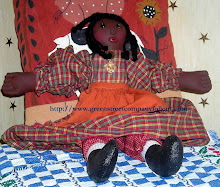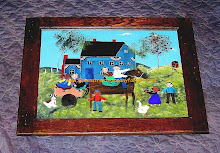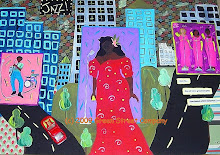This latest blog entry is a continuation of our previous discussion which provided useful information for folks interested in different type of folk art. In continuing with this them I’d like to dedicate this blog to discuss folk art dolls.
As I mentioned on my 06/13/2009 blog post my mother Sheila began designing and making doll patterns at an early age. Her mother, Jewell used to draw paper dolls for her when she was a child. These drawing would have a great influence on Sheila’s artwork as an adult. Her introduction to paper doll making, via her mother’s influence, would eventually become the impetus for the Green Street Company’s line of Ethnic and African American folk art dolls that you see today! The image below is a great illustration of how our folk art girl designs translate into a number of artistic medium, ranging from doll, to decorative arts, to paintings.
Doll making is an important genre of artistic creation that is often over looked. “Deemed by most as toys or playthings, dolls have for thousands of years represented so much more to humans than mere objects of amusement. Religious objects dedicated to gods in ancient temples, collectibles, worry dolls that carry the weight of our worries before we go to sleep, sometimes made of wood, clay, stone, to eventually fabric, porcelain, plastic and more; dolls have in their evolution become a medium of artistic expression for many (Read more at: http://news.deviantart.com/browse/deviantart_inc/deviantart_blog/ )
For those of you that are interested in learning more about folk art dolls or viewing them on display, the links provided throughout this blog will help you get started. As always the photo images that are contained in this blog also has direct links to other pertinent websites
Enjoy!
Michelle Edwards
Green Street Company Artist and Blogger
Relevant Information & Related Topics (Cont.)
Paper Doll Making
Obviously Sheila’s mother was not the inventor of the paper doll! If fact, paper doll making has been around since the Victorian era. To learn more about paper dolls or to view examples of paper dolls we suggest the following resources:
* Victoriana Magazine, http://www.victoriana.com/, is a free online publication, is a vibrant and inspiring e-zine that cuts through the complexities of modern life to illustrate what was beautiful in the past. Victoriana captures the pleasures and traditions of an earlier period and transforms them to be relevant to today’s living. They have a wonderful article on paper dolls. Click on the image below to go directory to that link.
* The Original Paper Doll Artists Guild, http://www.opdag.com/History.html is an organization of people who exchange ideas to encourage the art and hobby of paper dolls in the world today.
* The Arabella Grayson Collection, http://www.arabellagrayson.com/, is a Black paper doll collection that was displayed at the Smithsonian Institute’s Anacostia Community Museum. The Smithsonian News Desk issued a press release about the Grayson’s exhibition entitled, “200 Years of Black Paper Dolls: The Collection of Arabella Grayson.”
- Below is an example of one of Grayson’s dolls. It is a "Black Baby Articulated Paper Doll" (Littauer and Bauer, publisher, circa 1885, Germany). If you click on the image you will be taken directly to the press release.
Art Dolls & Collectibles
An excellent resource for people interested in antiques and collectibles is the online magazine Collector’s Weekly, http://www.collectorsweekly.com/. The magazine has a section that is features wonderful examples of antique dolls, folk art dolls, and doll articles! If you are doll collector the site also includes links to purchase dolls on the web. Below is a short article that I found on their website, which discussed a range of dolls. I’ve included images of some of the dolls that are discussed in the article.
People have made dolls for thousands of years for use as religious objects, toys, and holiday displays. Many traditional dolls, like the Japanese Kokeshi, are still highly desirable today. Many early American dolls were made of rags, or cloth, and are a reminder of the simple life in the 18th and 19th centuries.

You are looking at a set of Japanese wooden kokeshi nesting dolls that range in size from 3 3/4" tall by 3" wide (largest) to 1 1/8" tall by 6/8" wide (smallest). Four of the dolls open up at the middle to allow each one to be placed within each other.

Antique Emma Adams 1800's Folk Art Cloth Columbian Doll .
In the 19th century, French and German dolls were the most popular and innovative dolls in the western world. In the early 1850s, the Bebe doll appeared in France, starting the custom of making dolls in the form of infants and young children (as opposed to adults). The Germans caught on, and soon both countries were producing porcelain-headed dolls.

This is a silk face boudoir doll that was made in around the 1930's and is a French type doll with molded arms and legs with gold painted high heel shoes. This doll measures 24" tall.
30" German Bisque Head Catterfelder Puppen-Fabrik Doll.
Late in the 1800s, the French started making dolls with unglazed heads, and the unglazed colored clay more accurately represented a human skin tone. These dolls became known as bisque dolls, and they remain a staple of doll-making.
Shortly thereafter, German doll makers started experimenting with celluloid, a lighter-weight and less breakable material. Celluloid dolls were popular for a number of years, despite the fact that the material was flammable. Dolls in Europe, Japan, and America made of celluloid, such as the famous Kewpie doll, were eventually replaced by dolls made of plastic, or composition dolls, made of a mix of materials including glue and sawdust.
Old Original Simpich Goose Lady Doll Rare 50s Vintage.
African American Folk Art Dolls
* Ruby Lane, http://www.rubylane.com/, is an excellent resources to view and purchase black folk art dolls.
* Painted heart designs, http://paintedheartdesigns.blogspot.com/, is a blog that features primitive and one of a kind dolls and paintings. You can also view and purchase cloth and sculptured creations there.
* Folk Art Galleries, http://www.folkartgalleries.com/, periodically features black folk art dolls.
Below are some examples of black folk art dolls!

This doll has porcelain head, arms and legs w/ over-glaze black enameling; painted eyes; blue and white gingham dress w/ MOP buttons, upright spinning wheel has working treadle; seat and back of chair are upholstered in paisley fabric.

Black folk art doll made out of paper and clay by Little Glimpses Art Studio.
Examples of The Green Street Company’s African American and Ethnic Folk Art Dolls.
© Sheila Ann Originals
Thanks for reading Green Street Company Folk Art Talk! The next blog (Part III.C) is a continuation of this blog. It is intended to discuss and provide more useful resources for our readers.
Until then, keep craftin!
























